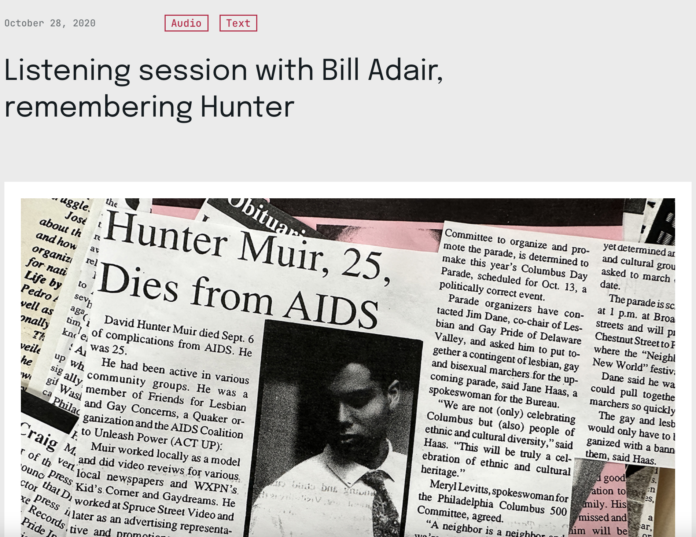“Wow, I just felt like — I just felt like, this sadness just saying his name out loud to you,” said Bill Adair to an interviewer during a listening session that was recorded in 2020. “I wasn’t expecting that. I haven’t thought about Hunter that much in the last few years, so it’s good to think about him again.”
The recording is part of a project called Remembrance — which partnered with local artists, activists, and community leaders to memorialize people the program says are “most at risk for being forgotten.”
“And it was just this really bizarre experience of having someone just — because of all the shame around HIV — just kind of, like, disappear from the universe,” Adair told the interviewer about his friend, Hunter Muir, who died at just 25 years old in 1991.
“There are other people that were closer to me that did die,” he said. “But for me, he’s always represented, you know, just the sheer numbers of people that just kind of disappeared with AIDS and HIV, and that the world, you know, will never get to know — and lost.”
Adair’s interview and nine others are now accessible through an online portal, which houses other previously unheard stories about people who lived with HIV/AIDS.
“We have many more that are sort of in the queue and will hopefully be added in the coming months and years,” said John Anderies, Director of the John J. Wilcox, Jr. Archives and Library at William Way LGBT Community Center, who said there are approximately 50 recordings available in the archive.
Before these oral histories are added to the online portal, they’re available to access through requested appointments — but the’ve most often been viewed by PhD students and professors until now. Anderies hopes the online portal will increase awareness of the collection and improve access for the public.
“One real target that I’m hoping for is younger queer and trans people who didn’t live through this who didn’t know what this was about,” Anderies said about a potential audience for the website in addition to survivors themselves. “I hope that they can learn a little bit more about the people that preceded them. I know they know that HIV and AIDS is not over with but it is sometimes surprising just how horrible those days were.”
College students have typically been hired as interns who have typically conducted interviews over their summers after learning about HIV/AIDS and the impact on Philadelphia. It’s a straightforward process, but post-production is what takes the team a lot more time — and money. Each recording requires professional transcription (which is accessible on the website) and three rounds of editing plus the work it takes to create art to accompany it and embed it on the website. Anderies said the rest of the remaining uploads (and future recordings) will all depend on funding.
“I would like to do a round of interviews that focus on artists and people that worked in the arts,” said Anderies, who was trained as a musician. “Obviously many, many artists were lost — but also the arts community stepped up in such a big way in Philadelphia in the 80s and 90s. And I just think I’d love to see that come to light.”
Anderies underlined that time is of the essence when it comes to listening to people tell their own stories. He was hoping to interview a specific artist, a member of ACT UP who used large sculptures to bring attention to social issues, but that person died last year.
When trying to decide which archived recordings to upload to the website first, Anderies said the team went back to the batch of interviews from the project’s first summer and chose pieces that amplified diverse voices — including the stories of early activists, longtime survivors, those who overcame drug use, and those with other experiences.
“Every one of them,” Anderies said, is meaningful to him. “They’re incredible. They’re also personal.”
The website includes multimedia elements from multiple projects — recorded interviews from both the Philadelphia HIV/AIDS Oral History Project and Remembrance, interactive timelines guided by newspaper clippings, video footage from a stage production, and performances of music and poetry.
“I kind of love that there are two sides of the coin,” when it comes to curating the archives, explained Anderies — underlining the connection between oral histories and physical objects. “I think they really illuminate one another a lot.”
He hopes to eventually bridge the online portal with physical exhibits by reimagining which materials are characterized as “memorials,” which tend to be obituaries but could also be “remnants of the way a community remembers someone,” such as their leather collection, artwork, letters and more.
“A lot of my work is dealing with the papers and records and ephemera and the ‘stuff’ that gets left by people that documents our history and that ‘stuff’ I think is incredible, amazing,” said Anderies. “It tells such incredible stories. It helps us to remember people that have passed that might not be remembered any other way.”
“Everything under the sun helps us to remember people,” he said. “And I would love to do some sort of exhibition of these materials at some point to get people really thinking about what makes a memorial and what its purpose is, how it helps us to both understand the past but also think about the present and the future.”
To view the full Philadelphia HIV/AIDS History Portal, visit paohp.wilcoxarchives.org.
